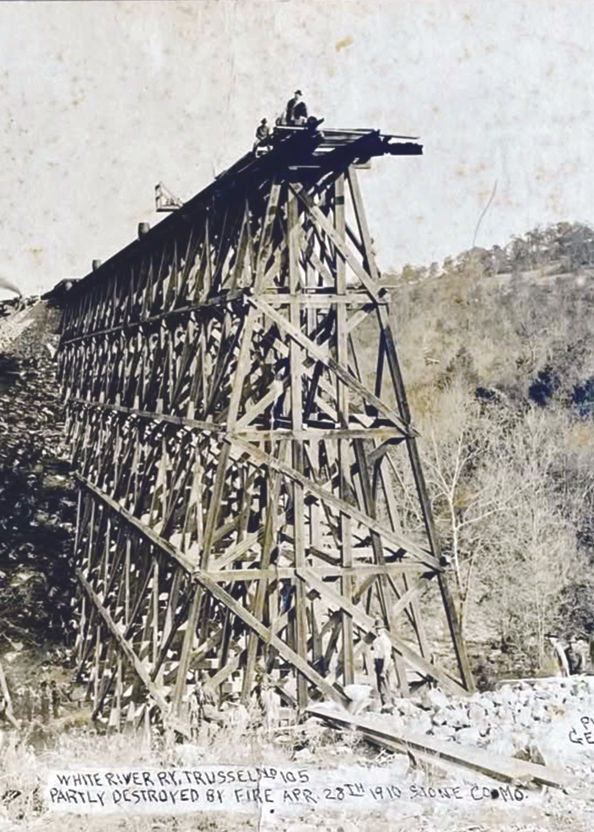Memories from the Homestead: Filling the trestles on the White River Railroad
- John Fullerton

- Jul 3
- 3 min read
In past columns, I've discussed the importance of our White River Railway, which runs from Carthage, Missouri, down to Diaz, Arkansas, not far from Newport.
It was this railroad that helped greatly in the early years of our area tourism, bringing visitors from everywhere to see the Shepherd of the Hills Country. In late December of this year, it will be 120 years since the railroad line was completed.
As I've pointed out previously, it was an unbelievable engineering feat to bring the railway to completion. Over 5,000 men worked during the construction which lasted 54 months and 4 days. The distance was 239 miles of completed track at a cost estimated then at $52,000 per mile. Today that would be the equivalent of nearly $1.8 million. By the way, the cost of the completed railroad in 1905 was three times higher than normal, due to the difficult Ozarks' terrain.

A total of five tunnels were constructed, and there were 284 bridges built as well. Our nearest tunnel is just six miles west of Garber, on the east side of present day Reeds Spring.
In 1915 a huge remodel project would begin on the railroad. Funding was officially in place by the Missouri Pacific Railway to fill 47 of the 57 high wooden trestles between Crane, Missouri, and Cotter, Arkansas. The upkeep of these numerous trestle structures was costing the railroad a massive amount of money.
Frequent sparks had ignited fires. One span to the west of Garber (trestle 105) was partially burned on April 28, 1910, resulting in $12,000 in damages. Heavy rainfall often caused washouts, and also to complicate the matter, termites were known to eat away at the wood.
Of the 47 trestles scheduled to be replaced by rock and dirt fill, ten of them would be rebuilt completely with steel and concrete. With filling being the easier method on the rest of the structures, a custom dump car was used to pour rock and dirt over the sides of each structure, creating an earth embankment that would be graded and leveled according to size.
Work on the largest trestle began in the fall of 1915 in Marion County, Arkansas. Known as the Georges Creek trestle, this structure was 122 feet in height and spanned a length of 1,900 feet. It was one of the most unique man-made structures in the area for its time.
To fill these trestles the first order of work was to complete a concrete culvert to handle the water flow, and the fill would be poured over that. These culverts all ranged in various sizes due to the width of the creek or stream. One in particular ended up being 378 feet in length. The dump cars then did their thing. Load after load would be dumped over the sides until they reached the top. Once grading was completed, the new fill would be 40 feet wide at track level. A number of the trestles were as high as seventy feet.
Work on these structures lasted into the early 1930s. Over 12,000 cubic yards of concrete and 500 tons of steel had been used to complete the work at the midway point of the project in the mid-1920s.
Here along Roark, beginning in 1921, seven trestles were filled from the tunnel at Reeds Spring, bridges 103 to 109. Bridge 109 here at Garber was filled and completed in August 1922. The railroad workers would hustle to fill two structures at the time and move onward.
Bridge 110 (the Fronaberger Trestle), which can be seen from the eastbound highway bridge of the Ozark Mountain Highroad at Roark Creek was updated to its current form in 1930.
So, with that, friends, it's safe to say: Yes, there are buried bones beneath the railroad tracks. Visit my dear friends at the Branson Scenic Railway for a trip into the past to learn more of our rich railroad history.
Happy trails, everyone!


Comments